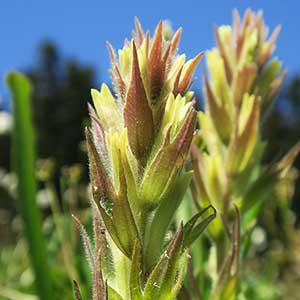Castilleja cryptantha
Castilleja kraliana
Mt. Rainier or obscure paintbrush, obscure Indian paintbrush, obscure paintbrush
Cahaba Indian paintbrush, Kral's paintbrush
few to several, erect or ascending, unbranched, hairs spreading, long, soft, eglandular, mixed with short stipitate-glandular ones.
solitary or few, erect, from a basal rosette that usually persists into anthesis, unbranched or few-branched from mid stem, glabrate proximally, hairy distally, hairs moderately dense, spreading, long, soft, mixed with short stipitate-glandular ones.
green, often with brown or purple veins, narrowly to broadly lanceolate, 1.5–4 cm, not fleshy, margins plane, ± involute, 0–3-lobed, apex acute to acuminate;
lobes spreading-ascending, narrowly lanceolate, apex acute to ± obtuse.
basal forming a persistent rosette, often withered at anthesis, usually suffused to varying degrees with red, sometimes green, oblanceolate to oblong-oblanceolate, 2–6 cm, not fleshy, margins plane, flat, 0-lobed, apex obtuse to broadly rounded to sometimes acute or subtruncate;
cauline green, sometimes proximal suffused with red or purple, linear to linear-lanceolate or linear-oblanceolate, 1.1–6.5 cm, not fleshy, margins plane, flat, 0–3(–5)-lobed, apex usually acute, rarely obtuse;
lobes erect to ascending, narrowly oblong to linear or narrowly lanceolate, to 1.8 cm, apex acute.
(2.5–)3–6 × 1–2 cm; green to dull brown or dull reddish purple throughout, or proximally green to dull brown or dull reddish purple, distally yellow on apices, broadly lanceolate to ovate, (0–)3-lobed;
lobes ascending, narrowly lanceolate, long or short, arising near mid length, apex acute or acuminate.
(2–)4–24(–33) × 2–4 cm;
bracts proximally greenish, distally bright yellow, rarely light orange, proximal narrowly lanceolate, leaflike, distal oblong to broadly rounded-oblanceolate, continuing to grow after anthesis and becoming greener and more leaflike, lateral lobes, if present, growing even more than central lobe, 0–5-lobed;
lobes erect, triangular or lanceolate, sometimes linear, short or medium length, arising above mid length, proximal bract apex acute, distal rounded, rarely central lobe shallowly toothed.
straight, 14–16 mm;
tube 11–14 mm;
whole corolla included within calyx;
beak adaxially pale yellow, 1–2 mm;
abaxial lip deep green, slightly inflated, 4–5 mm, 67% as long as beak;
teeth ascending, pale, 1.5–2 mm.
straight or slightly curved, (15–)17–23 mm;
tube 8–11 mm;
abaxial lip rarely exserted, beak exserted;
beak adaxially green or yellow-green, 5–7 mm, margins yellow or yellow-green;
abaxial lip ascending, deep green, slightly inflated, 2–3 mm, 20–30% as long as beak, apex rounded;
teeth ascending, green, whitish, or yellow, 0.5–2 mm.
proximally green or pale with green veins, lobes yellow, sometimes becoming deep red with age, 12–15 mm;
abaxial and adaxial clefts 3–7 mm, 25–50% of calyx length, deeper than laterals, lateral 1–3(–4) mm, 8–20% of calyx length;
lobes triangular, adaxial segments longer than abaxials, apex acute or obtuse.
proximally whitish or pale green, often aging purple, distally yellow, (13–)15–18 mm;
abaxial and adaxial clefts 4–7 mm, 40–50% of calyx length, deeper than laterals, lateral 0–0.2 mm, ca. 0% of calyx length;
lobes curved, oblong, apex rounded to truncate, sometimes emarginate.
= 24.
Castilleja cryptantha
Castilleja kraliana
Castilleja cryptantha is endemic to the vicinity of Mt. Rainier in the Cascade Range, with most populations found within Mt. Rainier National Park. Unlike most species of Castilleja, it is apparently self-pollinating (W. J. Duffield 1972); the small flowers are entirely enclosed within the yellowish calyces, which tend to grow deep reddish as they age. The purplish brown bracts are also unusual in the genus.
(Discussion copyrighted by Flora of North America; reprinted with permission.)
Castilleja kraliana is restricted to dolomite glades in Bibb County, which is a local center of endemism near the Cahaba River. Castilleja kraliana has mostly entire, bright yellow bracts and calyces 13–18 mm, and differs from the related C. coccinea, which has deeply lobed and red, rarely yellow, bracts and calyces 17–28 mm.
(Discussion copyrighted by Flora of North America; reprinted with permission.)


